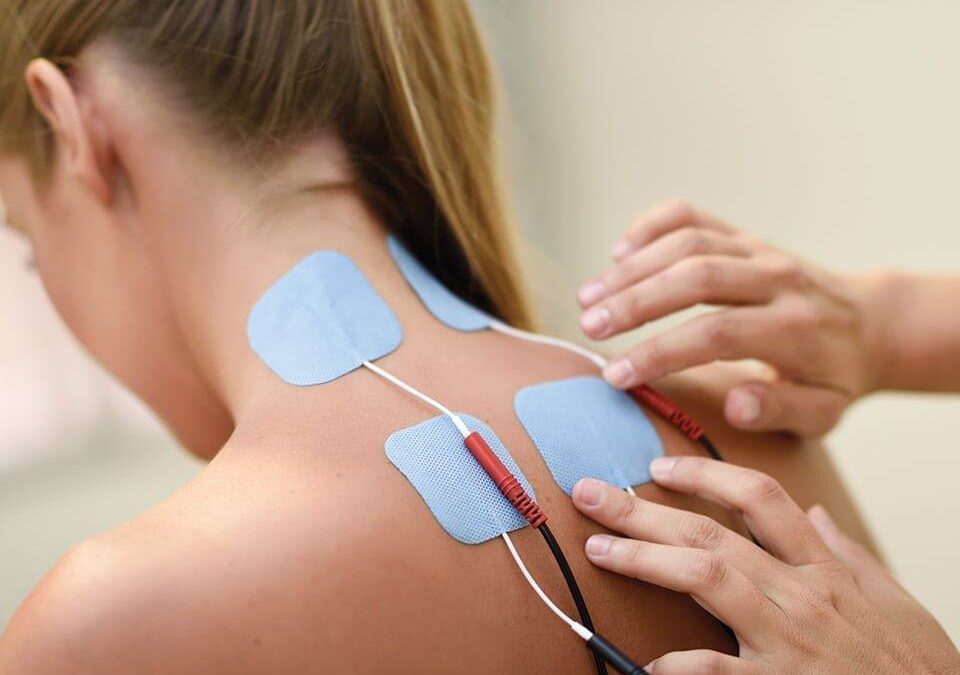by Rachel Kays, PT
When you have an appointment with your physiotherapist they may use different types of treatment depending on what is most effective for your given injury. When treating musculoskeletal conditions there are generally four main types of treatment a physiotherapist would provide.
- Manual therapy techniques involve the use of hands on therapy to help improve joint mobility by mobilizing or manipulating joints and muscles.
- Exercise prescription involves targeted, patient -specific exercises to help improve mobility, strength, or stability.
- Protective, adaptive, or assistive devices. This may include taping techniques, splinting, orthosis, canes, walkers, or braces.
- Modalities involve different types of tools to aid in treatment. Mechanical modalities include dry needling and acupuncture. Thermal agents include hot and cold packs. Electrophysical agents include TENS, NMES, and IFC. Electromagnetic agents include Laser and short wave diathermy. Acoustic agents include ultrasound and ESWT.
I’m going to dive a little deeper into some common modalities that may be used by your physiotherapist to give you a better idea of the differences between them and why we use them.
Mechanical modalities
- Dry needling – A thin monofilament needle is used to penetrate the skin to treat underlying muscular trigger points. When dry needling is applied to a dysfunctional muscle or trigger point, it can decrease banding or tightness, increase blood flow, and reduce local and referred pain. Unlike acupuncture, it is rooted in Western medicine. Acupuncture is based on Eastern medicine.
- Acupuncture – Like dry needling, acupuncture involves the insertion of very thin needles into the skin at strategic points in the body. Acupuncture is a key component of traditional Chinese medicine and has been used as a technique for balancing the flow of energy or life force, known as chi or qi, believed to flow through pathways (meridians) in the body. By inserting needles into specific points along these meridians it is believed that energy flow will be re-balanced. In Western medicine, acupuncture is used to help stimulate nerves, muscles, and connective tissue, and decrease pain.
Electrophysical agents
- Interferential Current (IFC) – is the use of two medium frequency currents applied to the body in such a way that the two currents are designed to “interfere” at the location being treated. Interference leads to cancellation of frequency and thus at the point of interference, a low current is produced in the tissues. Depending on the parameters set, low frequency can stimulate sensory and motor nerves to create pain relief, stimulate muscles, increase blood flow, or reduce edema. This is often used for pain relief and is used continuously for anywhere from 10 minutes to a half an hour. The sensation is usually described as a buzzing/tingling sensation.
- Transcutaneous Electrical Nerve Stimulation (TENS) – a method of electrical stimulation used to trigger sensory nerves or motor nerves to decrease pain. High frequency TENS (80 – 150Hz) is used to stimulate sensory fibers in the skin which sends signals faster to the brain than pain receptors in order to decrease pain. This usually feels like a buzzing, tingling, pins and needles sensation. Low frequency TENS(2-10 Hz) is used to stimulate motor fibers which are thought to stimulate the release of encephalin, an opioid in the spinal cord. This usually feels like a prickling, burning, or poking sensation. TENS is very similar to IFC.
- Neuromuscular Electrical Stimulation (NMES) – a method of electrical stimulation used to trigger motor nerves and muscle fibers. This form of treatment can be used to strengthen weak muscles, help with muscle re-education/coordination, decrease effects of disuse atrophy (i.e. stimulates a muscle that isn’t otherwise working properly). Unlike IFC and TENS you will usually feel your muscle twitch with this form of treatment and you may often be asked to actively contract your muscle at the same time the machine is on.
Electromagnetic agents
- Low Level Laser Therapy (LLLT) – is a form of light therapy. Think of the infrared lasers you see in movies and TV that can cut through glass but at a WAAAAAY lower dosage. Because the dosage is so low it is thought to cause no detectable temperature change in the tissue but create microscopic changes to help with tissue healing. LLLT has been used for wound healing, inflammatory conditions, and some soft tissue injuries.
Acoustic agents
- Extracorporeal Shockwave Therapy (ESWT )- a type of high intensity acoustic wave that carries shockwaves (a controlled explosion producing a sonic pulse) outside the body at high frequency and very high pressure. Force is applied over a very short period of time (less than a microsecond) resulting in a compression phase followed by a tension phase. Think of shockwave therapy kind of like a mini jack hammer. Sometimes it can be an uncomfortable sensation depending on the area of application and how sensitive the area is. Shockwave therapy can be used to treat tendinopathies, muscular trigger points, and dissolving calcifications.
- Ultrasound- is a form of acoustic energy. Sound waves travel through a medium (usually ultrasound gel or water) to penetrate tissue and create heat at a deeper level than a superficial hot pack. This heat can help to increase blood flow to the area, increase flexibility of tissue and reduce pain. A therapeutic ultrasound, which is used by physiotherapists is different from a diagnostic ultrasound which is used by an ultrasonographer. Diagnostic ultrasound is used to diagnose different medical conditions by generating an image.







Your physiotherapist should always inform you why they plan to use a certain treatment and ask for your consent first. If you are unsure about a type of treatment make sure to ask more questions!
To book an appointment with Rachel at our Stratford location:
Book online here or call us at (902) 370-2327.

